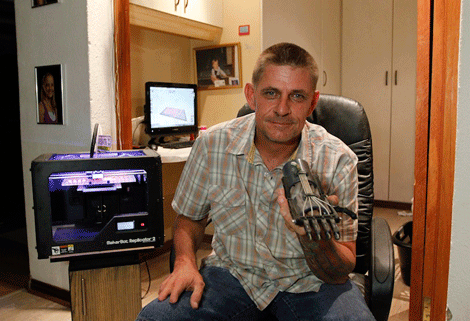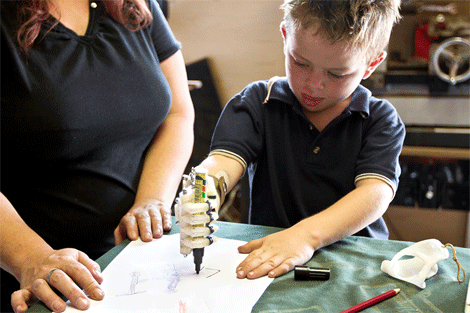
3D printing not only helped the collaboration of this design over 10,000 miles, but proved a cheap production method
A mechanical 3D printed hand, designed and produced using a MakerBot Replicator 2 desktop 3D printer has bridged 10,000 miles between Washington and Johannesburg to produce a life-changing prosthetic.
The idea for Robohand was originally conceived by South African Richard Van As to replace four severed fingers that he lost in a woodworking accident in 2011.
Struggling to find a cost-effective means of creating substitute fingers – prosthetics made specifically for him, could cost upward of $10,000 per finger – he contacted Ivan Owen, a US-based theatrical prop designer specialising in hands.
The two collaborated to create a design for working fingers that could be inexpensively built, taking advantage of the ability to share files online and 3D print the parts for different iterations, and making the design open source for cheap local production for adults and children alike.

Richard Van As with the Robohand he designed using his MakerBot 3D printer
Ivan, who played a big part in the initial design stages of Robohand, says he studied the anatomy of crab legs and human fingers to get the basic muscle and tendon structure. The result is a simple assembly that Richard believes anyone can make themselves.
While a full set of prosthetic fingers may cost thousands of dollars, all of the Robohand parts that are made on the MakerBot Replicator 2 Desktop 3D Printer add up to roughly several dollars ($2.50 USD) in material costs and the total cost is around $150 USD.
“The impact that utilising the MakerBot Replicator 2 Desktop 3D Printer had was incredible,” said Ivan Owen. “It dramatically increased the speed at which we could prototype and try out ideas. It gave us the ability to both hold physical copies of the exact same thing, even though we were separated by 10,000 miles.”

Liam was one of the first children to benefit from Robohand
After posting his story, Van As received emails and Facebook messages from parents whose children were perfect candidates for a Robohand of their own. The cost of purchasing a traditional prosthesis is often far too much for the family, especially since the child is fast out-growing them in a few months.
Having built its first child’s Robohand in January 2013 the word spread, and other children wanted their own Robohands, sized just for them.
The files, including the assembly instructions, have all been posted online on MakerBot’s Thingiverse community, with the designs now downloaded more than 3,500 times in just three months.
Visit here to support the Robohand project
https://youtube.com/watch?v=WT3772yhr0o%3Frel%3D0






